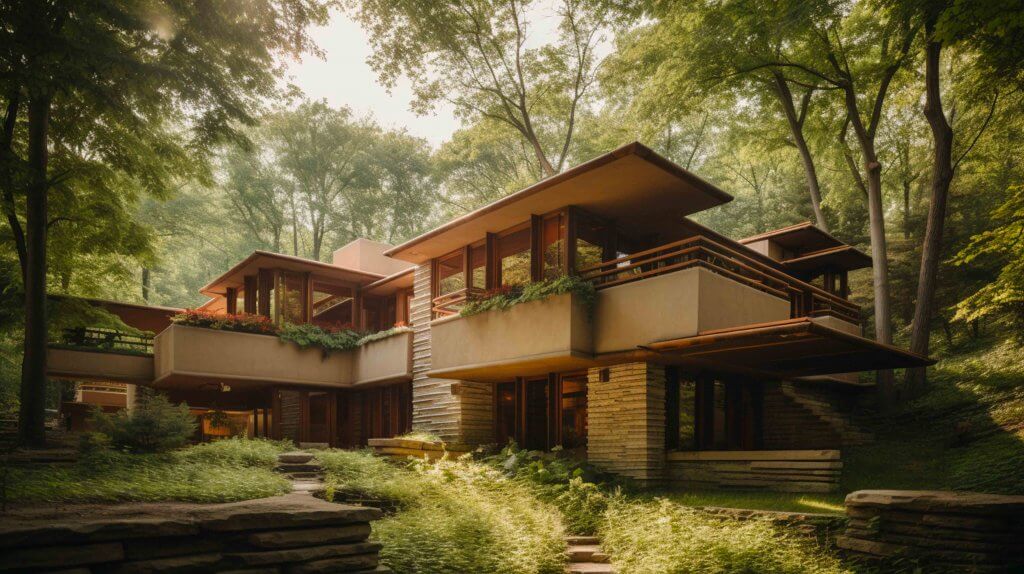Organic architecture is an art form that embraces nature and seeks to harmoniously integrate buildings into their surroundings. Such an approach to architecture is based on organic, fluid principles inspired by nature itself.
Over the decades, several visionary architects have emerged as pioneers of this architectural school, giving the world unique works that challenge the boundaries of tradition and innovation.
Let’s take a closer look at some of the major exponents of organic architecture, as well as a number of important names who have been influenced by it.

Frank Lloyd Wright
Regarded as the father of organic architecture, Frank Lloyd Wright laid the foundations for this movement at the end of the 19th century. His works, such as the famous Fallingwater in Pennsylvania, embody the harmony between man and nature. His “prairie style” philosophy and innovative use of space have inspired generations of architects.
Richard Neutra
Richard Neutra, another master of 20th century architecture, contributed significantly to the development of an organic approach to design. Born in Austria in 1892, Neutra emigrated to the United States, where he embraced modernist philosophy and developed a distinctive architectural language. Neutra designed works such as the Lovell Health House in Los Angeles, which is an eloquent example of his interest in integrating buildings with the surrounding landscape. Neutra’s attention to functionality, natural light and visual harmony made him a key figure in the evolution of organic architecture, influencing generations of designers with his fusion of modernist aesthetics and naturalistic sensibility.
Alvar Aalto
Finnish architect Alvar Aalto created iconic works the likes of Paimio Sanatorium, Villa Mairea and the Finland Hall. His attention to detail and innovative use of natural materials are the hallmarks of his architecture. Aalto’s endeavour to harmonise human experience with the built environment considerably influenced the development of organic architecture.
Bernhard Hans Henry Scharoun
Born in Germany in 1893, Bernhard Hans Henry Scharoun was an architect who left an indelible mark on the 20th century architectural scene. A member of the modernist movement, Scharoun is known for his organic and innovative approach to design. His most famous work is the Berlin Philharmonie, a bold example of architecture that challenges traditional boundaries. Scharoun experimented with fluid forms and dynamic spaces, seeking to create environments that inspire a sense of community and interaction. The Philharmonie is an icon of his vision, where architecture successfully blends with functional and cultural needs. Scharoun contributed significantly to the rise of organic architecture as a philosophy that reflects the dynamic nature of human interactions and the surrounding environment.
Frei Otto
Frei Otto, known for his work in the field of tensile architecture, has contributed significantly to the design of light and flexible structures, making some of the demands of organic architecture his own. His most iconic work is perhaps the German Pavilion at the 1967 Montreal International Fair. Through the use of lightweight materials and innovative techniques, Otto demonstrated that architecture can be sustainable, functional and aesthetically fascinating.
Glenn Murcutt
Known for his commitment to sustainability and integration with the environment, Australian architect Glenn Murcutt created works such as the Magney House and the Simpson-Lee House. His projects are designed to adapt to the climate and surrounding landscape, demonstrating that organic architecture can be a sensitive and conscious response to environmental challenges.
Carlo Scarpa
Carlo Scarpa was a very important Italian architect. His architectural vision is characterised by a discontinuity of materials. A notable example of his work is Villa Ottolenghi, built with concrete and stone. The villa blends with the surrounding nature through carefully curated details and the skilful use of materials, creating a harmonious union with the environment in which it is embedded.
Bruno Zevi
Bruno Zevi, born in Italy in 1918, was an influential architect. He is associated with the organic architecture movement through his writings and his commitment to promoting a more human and sensitive perspective on architecture. Zevi supported the idea that architecture should respond to human and environmental needs, embracing historical and cultural context. Through his literary works, such as “Knowing How to See Architecture” and “Modern Architecture“, Zevi helped spread awareness of the importance of an organic approach to design. His vision has influenced the education of many generations of architects, contributing to affirm the role of organic architecture in creating spaces that resonate with the essence of human life.
Jørn Utzon
Danish architect Jørn Utzon is famous for the majestic Sydney Opera House. He does not properly belong to the organic current, but was strongly influenced by it, especially by the work of Alvar Aalto. His vision of an architecture that blends with its geographical location gave birth to one of the most recognisable architectural icons in the world. Utzon demonstrated that organic architecture can be at once functional and spectacular.
Cesar Manrique
César Manrique is a Spanish architect and artist. He was born in Lanzarote, in the Canary Islands, in 1919. Although his work is not strictly classified as “organic architecture” in a traditional sense, he has played a significant role in creating architectural works that integrate with the surrounding environment in a unique way.
Manrique has developed a distinctive approach based on the conservation of the natural environment and respect for local culture. His most famous work is perhaps the César Manrique Foundation in Lanzarote, which is located in a structure built on a series of lava bubbles. This house museum is an example of how architecture can not only but blend with the geology and history of a place.
The here mentioned masters of organic architecture have shaped the way we perceive and interact with buildings and their surrounding landscape. Their legacy is still alive today in the works of many contemporary architects.
Through the use of innovative materials, a sustainable approach and a deep connection with the environment, they have built an architectural movement that is not merely an aesthetic response, but rather a philosophy that invites us to reconsider our relationship with the world around us.